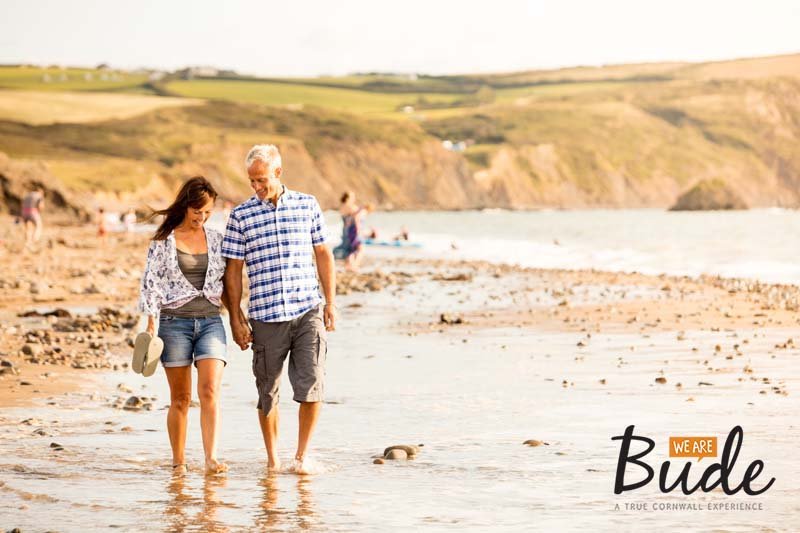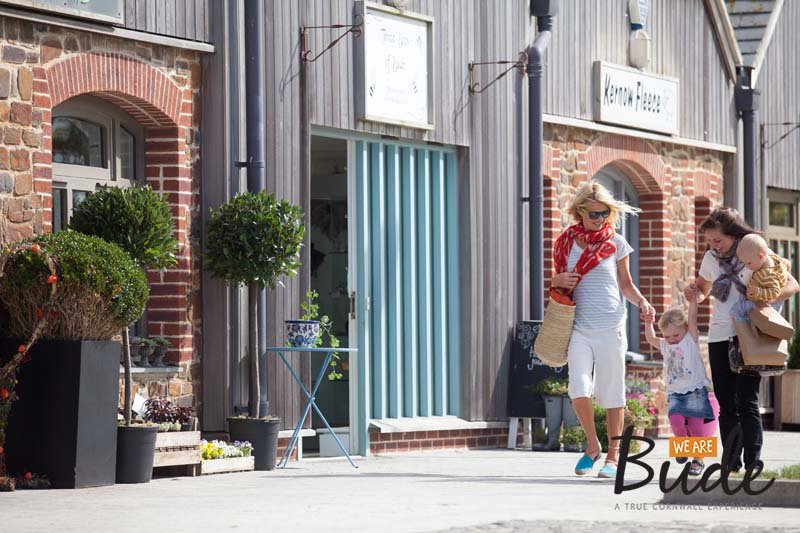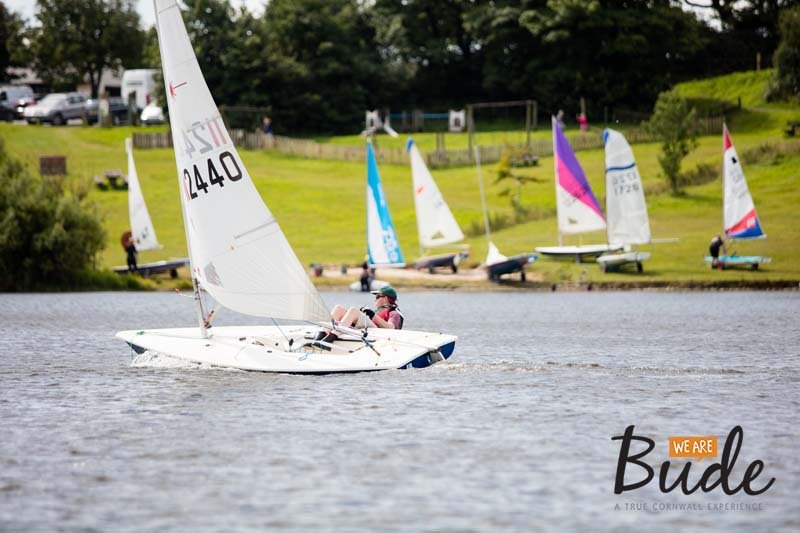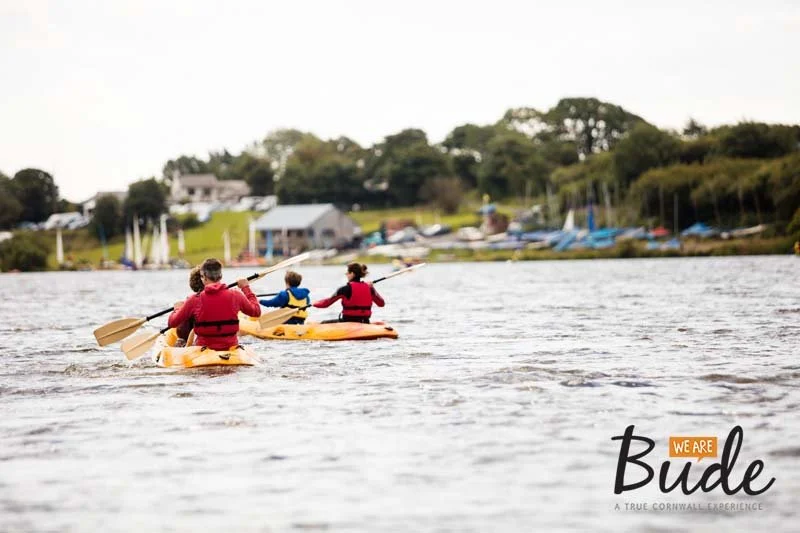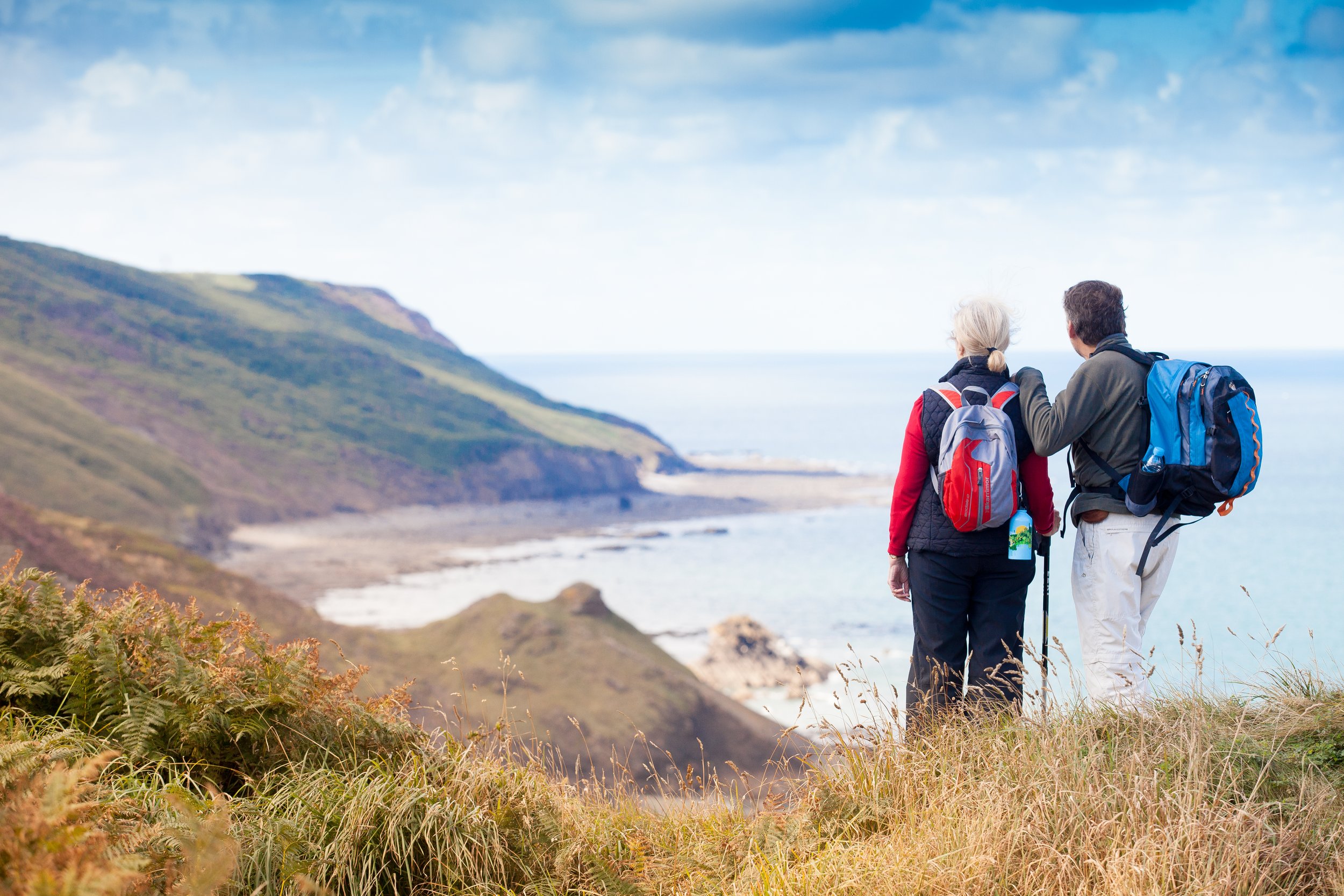
What to do in Bude…
From chocolate truffle making to surfing, what ever kind of break you’re looking for, Bude is the place to be
Bude is a small seaside resort town on the North Cornish Coast close to the Cornwall/Devon border. The growth of Bude in the early 20th century as a resort town was in part due to the arrival of a railway branch line, the Victorian liking for bathing in the sea, and the romance of wild seas and scenery.
-
The Arthurian legend also drew attention to the area around Tintagel, which is a little further down the coast.
Bude has a small fishing industry, and a range of small local businesses, but tourism is the mainstay of the local economy. Bude has a wide range of shops, cafes, pubs and restaurants, and even at the height of the season it offers plenty of variety.
In times past Bude was a coastal port of some significance. The Bude Canal, built between 1819 and 1825, was designed in the main to carry ‘Bude Sand’, which was high in salts and suitable for digging in to the local clay soil, throughout the area to improve its drainage and to augment yields.
The Canal company improved Bude harbour and constructed a breakwater, which provided shelter from the sometimes cruel seas. The sea-lock was eventually enlarged to allow vessels of up to 300 tons to enter the canal and tie up in either the Lower or Higher Wharf. Some of the grain stores and warehouses are still standing today although they have been converted for a variety of different uses, from apartments to shops and restaurants. 2009 saw the regeneration of the Lower and Higher wharves and the higher canal lock gates have been reintroduced. A walk along the canal path is a must, the natural beauty of the canal and the wildlife is spectacular.
The Old Lifeboat House is situated between the two wharves by the site of the former swing bridge, and is now converted into four comfortable self-catering holiday apartments.
As well as having a very interesting history, Bude has much to offer people of all ages, throughout the year.
The environment is superb. The South West Coast Path follows the cliffs and beaches through Bude, and offers excellent and sometimes challenging walking. Bude is on the Sustrans cycle network and is a focal point for many routes throughout Devon and Cornwall. Crooklets Beach, Summerleaze Beach and the fine beach nearby at Widemouth Bay offer fine waves for swimmers, surfers and kayakers.
Families can relax in the safety of the Bude Sea-Pool, which has just been upgraded to meet modern safety standards. You can take to the waves under the supervision of RNLI lifeguards (throughout the holiday season at specified times of the day).
Attractions such as Clovelly, Dartmoor, Padstow, Eden Project, Morwellham Quay, The National Maritime Museum, Tintagel Castle and many others are within easy reach by car and there are bus links to most attractions and villages.
Paddle boarding on the Bude canal
Stand up paddle boarding is available just a 5 minute walk from your hotel room to lesson! Take a look at what our our recommended school have to say…
‘Our school is based both on Summerleaze beach and Bude Canal, offering surf and SUP lessons for the whole family; all ages and abilities are welcome. We have been running for over 20 years and pride ourselves on the highest professional standards, while a good time is guaranteed! Follow the link to find out more and to book (call or email to use your hotel discount)’
Canadian canoeing and body boarding
Canadian Canoeing is a traditional long canoe that can seat between 2 and 4 people, as per the Inuit and Canadian First Nation people used many years ago. You use a single blade paddle which you use one side only.
It is a great activity requiring a little bit of team work and learning steering skills as you paddle up Bude Canal, an area of outstanding natural beauty.
Surfing
North Cornwall’s beaches are famous for their beauty and those in Bude are no exception. Vast expanses of clean, golden, sandy beaches are often backed by the rugged cliffs. With enormous differences between high and low tide, the beaches are constantly changing shape.
The water levels rise and fall dramatically within a couple of hours and the sea level will cover an area of 60 football pitches with up to 7 metres of water during high tide. It is this never-ending flow of the tides that gives you the opportunity to enjoy a 4 mile walk along the shoreline from the Bude beaches all the way up to Sandymouth when the tide is out.
-
With the prominent features of the breakwater, Barrel Rock, canal lock gates and the river Neet flowing into the sea here, it is probably Bude’s most picturesque beach, inspiring painters, photographers and visitors alike. The little fishing boats banked on the sand whilst waiting to go out with the next high tide, add to that special charm and atmosphere.
Even at high tide there is a good stretch of sandy beach available and with the tide out Summerleaze is truly a joy to behold. The beach is an easy 5-minute walk from the Brendon Arms and also the nearest beach to the town centre. Popular with families, Summerleaze offers a car park close by, level access from several sides as well as a beach cafe and public toilets.
Lifeguard cover is provided from 1 May until 30 September. Another feature of Summerleaze is the Sea Bathing Pool which it’s advisable to use when the tide is out or the sea is rough. It’s said to be one of only two left in the UK. No dogs or horses are allowed on the beach between 1 May 30 September. Beach wheel chair hire, beach hut/deck chair/windbreak hire are all from the beach office.
-
Although a little pebbly and rocky at the top, Crooklets Beach offers a huge expanse of golden sand once the tide is out. It is very popular with surfers and also home to the Bude Surf Life Saving Clubhouse.
The Bude SLSC holds surf lifesaving demonstrations on Crooklets Beach every Tuesday evening (6:30pm) during the summer and they are well worth a visit.
Lifeguard cover is provided from 17 May to 21 September.
-
A beach of haunting beauty. Although quite pebbly at the top, it offers a huge expanse of sandy beach with the tide out. With towering cliffs on both sides, it has a bit of a cove feel to it.
Children will be very happy playing on the fine sand, in the many rock pools and in the stream running down through the beach. Owned by the National Trust, it has a little car park halfway down the hill.
Although there aren’t any facilities such as public toilets. Lifeguard cover is provided from 5 July until 31 August.
-
A wild and romantic cove, which is appreciated most for its rugged setting. Dominated by the spectacular peak of Steeple Point Cliff, it is favoured by many as a quiet retreat away from it all.
Swimming is not recommended as the currents are extremely dangerous and razor-sharp rocks add to the hazards. No lifeguard cover is provided.
-
Widemouth Bay is very popular with bathers and surfers alike. Although it looks like one huge beach, stretching across almost 1.5 miles, it is actually divided into the North Beach and South Beach (also called Black Rock) by a natural barrier of rock.
Widemouth offers fantastic conditions to learn surfing or body-boarding, which is why many of the local surf schools have their base there.
A big car park, public toilets and beach cafe are available. Lifeguard cover is provided from 1 May until 30 September (North Beach). Cover on Black Rock is from 17 May until 21 September.
-
Another beach of haunting beauty, yet not the perfect one for those looking for sand and surf. Covered with thousands of pebbles, it is more of a retreat for those wishing to observe wildlife such as seals and dolphins as well as birds of prey and waders.
Millook is also of huge geological interest with its famous zig-zag cliff, towering high above the shore. No lifeguard cover is provided.
Walking
For walkers hiking the coastal path we suggest visiting iWalk Cornwall for self guided walks along the Coastal path as part of the circular route.
-
A 10-mile (16km) walk to Crackington Haven has an easy start at Bude Canal and takes you past the ‘Tower of the Winds’ (or the structure at Compass Point aka ‘The Pepperpot’) where on a clear day you can see inland Devon and Dartmoor Tors.
Pass Widemouth Bay to Crackington Haven and continue for 6.7 miles (11 km) into Boscastle or catch the regular bus back to Bude.
-
Head north to Morwenstow, and perhaps on to Hartland Quay (15 miles / 24km). With relentless ascents and descents, this is possibly the hardest stretch of the South West Coast Path. Here, the sandy beaches become rugged and the path gets steeper. Pass Sandymouth and Duckpool and you will find Coombe Valley a welcome rest spot, where in July the glow-worms are a fascinating sight. Finish the coastal walk at Hawker’s Hut, the National Trust’s smallest property.
Bude has so much to offer, take a look at other activities and places of interest below…
-
The Falcon hotel is situated opposite the Lower wharf, which is home to several local artisans with skills to share! From ceramics decorating at the Kitchen Front in a 1940’s inspired setting www.thekitchenfront.co.ukWorkshops in fused and Tiffany glass at Beau Nidol www.beaunidol.co.ukFurther into the town you can try your hand at chocolate truffle making with Sweet P Confectionery www.sweetpconfectionery.co.uk
-
BUDE CASTLE Formerly the home of Victorian inventor Sir Goldsworthy Gurney, Bude Castle is now a heritage centre with exhibition galleries, an archive with research facilities, an education room, a shop and a restaurant. It has breath taking views to the breakwater and Chapel Rock and over Summerleaze Beach to the sea beyond.
BUDE CANAL AND THE SEA-LOCK GATES These were built in 1823 to transport sand, coal and limestone to farms in rural north Cornwall and north Devon. The sand was valuable as fertilizer. Many original features have been restored, including the locks, bridges, towpaths & lower wharf. You can explore all the heritage of this ancient waterway on foot or by canoe, kayak or rowing boat. The sea lock gates were used more frequently in the days of sail to ‘lock’ vessels into the safety of Bude’s Inner Harbour. But the locks are still in use today and are the site of the annual Blessing of the Sea ceremony.
CLOVELLY This quaint village transports you back to a romantic past of smugglers, wreckers and fisher-folk. It consists of little more than a steep, narrow, cobbled street snaking down to a picture-postcard harbour. The street is car-free, so access is on foot, by donkey or by sledge, though a Land Rover operates the return journey in the summer months. Houses line the street and there are a few shops and a pub. If you do nothing else in North Cornwall, you should cross the Devon border to see Clovelly.
BOSCASTLE This attractive village is set around a natural inlet protected by two stone harbour walls. It is the only significant harbour for 20 miles. Much of the land in and around Boscastle is owned by the National Trust. In 2004 BBC2 broadcast a TV series entitled “A Seaside Parish” which featured the newly-appointed rector, Christine Musser, as she coped with the aftermath of the flash flood which devastated the village.
TINTAGEL CASTLE This ancient village and spectacular Tintagel Castle, which is situated on a rocky eminence battered by the sea, are forever associated with the legends surrounding King Arthur and the Knights of the Round Table. Excavations revealed that the Tintagel headland was the site of Celtic monastery or a princely fortress after the Roman withdrawal from Britain.
PORT ISAAC This charming village was constructed during the reign of Henry VIII. Its prosperity stemmed from coastal freight and fishing, which continues today. Rich catches of fish, crab and lobsters are landed regularly. In summer the group called Fishermen’s Friends sing sea shanties every Friday night. The village has been used many times as a film location, most recently as the fictional “Portwenn” in the TV series “Doc Martin”.
THE CAMEL TRAIL The Camel Trail, available free 365 days of the year, winds through some of Cornwall’s most beautiful and little-known countryside. Cornwall County Council converted 11 miles of disused railway beside the River Camel linking the towns of Bodmin, Wadebridge and Padstow. Travel along the Camel Trail and enjoy the spectacular scenery of the Camel Valley. Being an old railway track, the Trail is virtually level all the way. Bicycles may be hired from hire shops in Wadebridge or Padstow.
-
HARTLAND ABBEY Hartland Abbey and Gardens are only one mile from Hartland Quay (near Clovelly). Visitors may wander around the beautiful gardens and grounds which lead to the rocky cove. Peacocks and guinea fowl roam at will, whilst donkeys and black Welsh Mountain sheep graze the Old Deer Park. Hartland Abbey is the lived-in home of the Stucley family and contains collections of pictures, furniture and porcelain. Seehartlandabbey.com
DOCTON MILL, HARTLANDThis is situated near the Spekes Mill Mouth coastal waterfall and beach. The water mill originated in Saxon times, and has been cleared, creating ponds and leats; foot bridges were built over the river and many smaller streams. A swampy area has been drained to make a stream and marsh garden with ligularias, primulas and ferns. Everything is as natural as possible. In spring there are narcissi, camellias, primulas, magnolias. In summer there are old shrub roses and perennial geraniums. See doctonmill.co.uk
PENCARROW HOUSEFour miles northwest of Bodmin and surrounded by beautiful gardens, this house has been occupied by the Molesworth family and their descendants since Elizabethan times. A guided tour around the 50-room Georgian mansion reveals a superb collection of antique furniture, paintings and porcelain. Pencarrow is approached by a magnificent mile-long carriage drive through an Iron Age hill fort. Around the Palladian mansion are Grade II* formal gardens. They include a large Victorian rock garden and ice house, 50 acres of parkland, lake and woodland with more than 700 varieties of rhododendrons and many camellias, as well as a Celtic cross. Seepencarrow.co.uk
LANHYDROCK HOUSE AND GARDENS These are located 2.5 miles south east of Bodmin. Superbly set in wooded parkland of 1,000 acres and encircled by a garden of rare shrubs and trees, Lanhydrock has fifty rooms open to view. Through the crenellated gatehouse, dated c1641, you can take an idyllic walk down to the River Fowey at Respryn Bridge and back through the woods. See nationaltrust.org.uk – Lanhydrock
THE LOST GARDENS OF HELIGANThey may not be lost any more but they are certainly hard to find! Travel south from St Austell on the B3273 towards Mevagissey. Heligan, seat of the Tremayne family for more than 400 years, is one of the most mysterious estates in England. It offers over 200 acres for exploration. Visit the Victorian Productive Gardens, the romantic Pleasure Grounds, the pioneering Wildlife Project, lush sub-tropical jungle and much, much more. See heligan.com
TREBAH GARDENThis is in Mawnan Smith, near Falmouth, and provides a sub-tropical paradise with a stunning coastal backdrop. It is one of the Great Gardens of Cornwall and is rated among the 80 finest gardens in the world. See trebahgarden.co.uk
THE EDEN PROJECT This is at Bodelva, near St. Austell. In the Rainforest Biome you can trek through the steamy rainforests of Malaysia, West Africa and South America – it is the world’s largest conservatory. In the Mediterranean Biome you can take a journey through the Mediterranean-type climates of the world, including those of South Africa and California. The Core is the name of Eden’s Education Centre, a fantastic building that has become an inspirational hub for events, exhibitions and learning for everyone. edenproject.com
TRERICE We warmly recommend this Elizabethan manor house buried in verdant countryside near Newquay. Its yellow-grey stone, pretty Dutch gables, authentic furnishings and well-restored gardens make for a delightful visit. We enjoyed its peace and quiet but we gather that Tudor-style family activities are laid on some days – so it’s well worth checking the web-site.
BUCKLAND ABBEY Originally a rich Cistercian Abbey in the fertile Tamar valley, this estate was bought by local hero, Sir Francis Drake, with the money gained from his buccaneering exploits. The Abbey buildings have been much altered over the years but remain very attractive, as Rupert and Chris demonstrate. What interested us most was the Great Barn, one of the largest in the country and proof of the plentiful produce the Cistercians gained from their 20,000 acres.
COTEHELE HOUSE In contrast to Buckland Abbey, Cotehele has been little altered since medieval times. Even furnishings, such as the weaponry in the entrance hall and the tapestries in the dining room, are original. We could well imagine the Edgecombes living in this stone manor house after they acquired it in 1353 – especially as at some stage of their occupation they included certain members of the Brendon family. Below the house are the remains of an old quayside on the Tamar as well as a working Victorian water mill where you can often buy freshly milled flour and newly baked bread.
LANHYDROCK HOUSE Originally a 17 th century mansion, Lanhydrock was substantially refurbished by the wealthy Robartes family in the 19 th century – although we could still walk through the old crenellated gatehouse. Today it provides a wonderful lesson in Victorian and Edwardian country house life “upstairs, downstairs and in my lady’s chamber” before the First World War brought it all to an end. The young heir, the daughters’ potential husbands and many of the servants lost their lives and the family lost Lanhydrock. You will need plenty of time here as the estate covers 900 acres of gardens and woodland and includes its own church.
TRELISSICK GARDENS This estate, with one of the most beautiful settings in the country overlooking the Fal estuary, belonged to families whose wealth derived from Cornwall’s once important tin mines. As well as admiring the view from a convenient stone bench, four members of the Brendon family wandered around the stunning gardens but were not lucky enough to arrive on a day when the house itself was open. That will have to wait for another visit.
-
The Golf Courses listed are in order of their proximity to Bude.
Bude Golf Club – founded in 1981, this is an 18-hole links golf course in the centre of Bude. Par 71. (ask us about discount for our residents)
Holsworthy Golf Club – 8 miles. Founded in 1937, it is probably the best maintained parkland course in Devon. Par 69.
Launceston Golf Club – 16 miles. It offers challenging rounds for all standards of golfer. Par 70.
Bowood – 16 miles. The course at Bowood measures 7317 yards from the Championship tees and provides a great day out for both scratch and occasional golfers. Par 73.
Roserrow Golf and Country Club – 26 miles. It is a beautiful 18-hole golf course near Port Isaac which includes a wooded valley with a stream running towards Polzeath beach. Par 72 www.roserrow.co.uk/golf.htm
Lanhydrock – 30 miles. The course in Lanhydrock, Bodmin is a sheltered wooded valley offering an enjoyable challenge to golfers of all abilities. Par 71
Okehampton Golf Club – 30 miles. It nestles in the heart of Devon sheltered by the highest tors of Dartmoor on the north edge of Devon’s National Park. Par 67
St Enodoc – 33 miles. It is one of the finest links golf courses in South West England. The course, designed by James Braid, has undulating fairways, firm greens, some blind shots and the added bonus of some of the greatest sea and estuary views of any course in the world. Par 69.
St. Mellion Golf Club – 35 miles. It has 2 championship courses situated in the Tamar Valley including one designed by Jack Nicklaus.Par 72.
Trevose – 36 miles. There are challenges and enjoyments for every golfer at Trevose Golf Club in St Merryn (near Padstow) as each of the 3 courses blend effortlessly into the unique landscape. The Championship course was designed by Harry Colt in 1924 with four sets of tees. Par 72/71.
-
LAUNCELLS, NEAR BUDE John Betjeman described this hidden gem as the ‘least spoilt church in Cornwall’. It is full of wonderful Cornish woodwork, from high wagon roof to imposing Georgian box pews and glorious Tudor bench-ends. They are virtually unrivalled throughout England.
ST MORWENNA, MORWENSTOWThis simple Cornish church, situated in a magnificent position overlooking the sea and high cliffs, is of Norman origin (as the ancient font indicates), though a Saxon place of worship probably once stood on the site. The famous poet, parson and eccentric Robert Stephen Hawker was the vicar of the parish for much of the Victorian age. Among other things, he wrote the Cornish National Anthem, “And shall Trelawny die”. Ancient relics abound in the churchyard, including the graves of 28 sailors whom Hawker buried after shipwrecks. On a nearby cliff is Hawker’s Hut (the National Trust’s smallest property) where he wrote poems and smoked opium.
COLLEGIATE CHURCH OF THE HOLY CROSS, CREDITONConveniently situated on the beautiful A3072/A377 route between Bude and Exeter, the Collegiate Church of the Holy Cross at Crediton (it stones as red as the earth of Devon) is well worth a visit. We spent ages there seeking out medieval tombs, monuments, seats (pointed out here by Rupert) and a carved Flemish chest used as an altar. And it was impossible to miss the huge neo-Gothic screen built as a memorial to Sir Redvers Buller, a soldier revered in Devon despite his disastrous performance in the Boer War.
COME-TO- GOOD MEETING HOUSE, FEOCK Just south of Truro, we found the tiny 18th century Quaker meeting-house at Come-to-Good. The thatched cob building is as evocative as its name. Still used by local Quakers today, it is kept open so that you can go inside to view its bare walls and uncushioned benches. A little-known gem.
ST JUST, ROSELAND The Roseland Peninsula can be reached either by road or by the King Harry ferry crossing. Overlooking the Fal estuary is this 13 th century church surrounded by an exotic sub-tropical garden planted by Edwardian botanist John Tresider. The whole peninsula is worth exploring for its spectacular views – and perhaps you’ll be more successful than we were at finding the elusive St Anthony Church on its southern tip.
THREE SPECTACULAR CHURCHES AROUND THE EDGE OF BODMIN MOOR All are within easy driving distance of Bude. They are clearly marked on the road atlas and it is wiser to be guided by this rather than a sat-nav which, in our experience, can lead you down treacherous lanes marked (too late for retreat) ‘Unsuitable for Vehicles’.
ST PROTUS AND ST HYACINTH, BLISLAND Set just off the green of this pretty village on the western edge of the moor, this granite Norman structure seems almost to be slipping down into the valley of the Camel River. The interior was restored by Victorian architect F. C. Eden, a favourite of John Betjeman’s, and is dominated by a rood screen blazing with colour and gilt. The village green is surrounded by Georgian and Victorian houses – and the Blisland Inn looks inviting.
ST NEOT, IN THE VILLAGE OF THE SAME NAME This church is justly described by Simon Jenkins as ‘a granite jewel-case on a southern slope of Bodmin Moor’. After walking through a porch protected from the Devil by Cornish crosses, you will be astonished by the glow of its stained glass windows, which are among Cornwall’s hidden treasures. The medieval ones are the finest, depicting Old Testament stories such as that of Noah – it also reveals much about ship design and sea-faring in old Cornwall. Look, too, for windows celebrating the local families who donated them and also for St Neot himself. After your exploration of these wonders, you may feel like some refreshment at the adjoining village pub.
ST NONNA, ALTARNUN (APPROACH FROM NEARBY A30 RATHER THAN NARROW LANES)
Diagonally opposite St Neot, on the north-eastern side of Bodmin Moor lies a church often described as the ‘Cathedral of Cornwall’. Situated in an attractive village on the River Inney, St Nonna serves a large rural parish, the richer inhabitants of which must once have paid for the carving of the 79 remarkable bench-ends for which the church is now famed. All made by the same hand in the 16th century, they depict religious symbols such as those of Christ’s Passion as well as ordinary moorland sheep, lewd jesters and a variety of grotesque creatures. Pagan associations can also be found in the fierce faces and serpents carved on the Norman font which must have terrified medieval parishioners.






